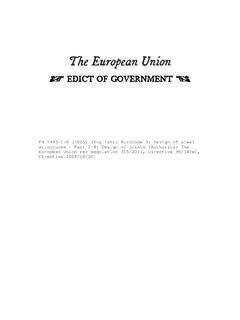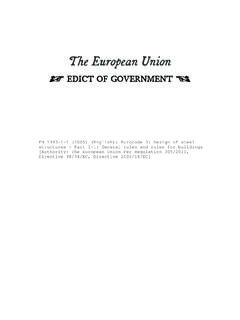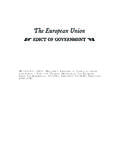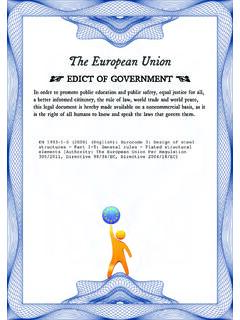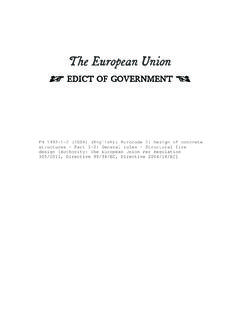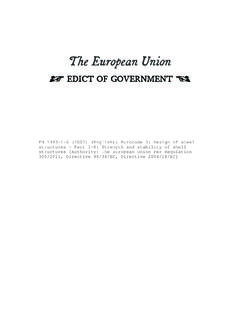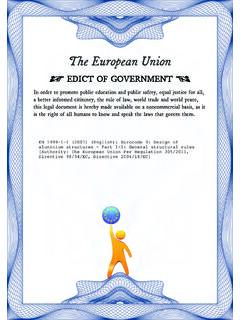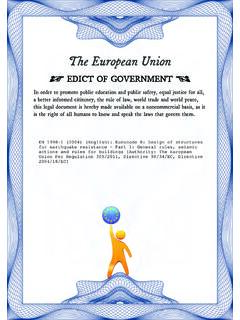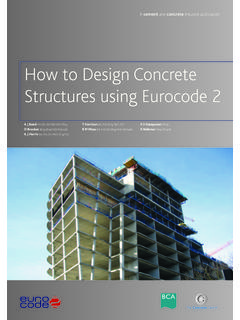Transcription of EN 1991-1-7: Eurocode 1: Actions on structures - …
1 The European UnionIn order to promote public education and public safety, equal justice for all, a better informed citizenry, the rule of law, world trade and world peace, this legal document is hereby made available on a noncommercial basis, as it is the right of all humans to know and speak the laws that govern them. EDICT OF GOVERNMENT EN 1991-1-7 (2006) (English): Eurocode 1: Actions onstructures - Part 1-7: General Actions - Accidental Actions [Authority: The European Union Per Regulation 305/2011,Directive 98/34/EC, Directive 2004/18/EC]EUROPEAN STANDARD NORME EUROPEENNE EUROpAISCHE NORM EN 1991-1-7 July 2006 ICS Supersedes ENV 1991-2-7: 1998 Incorporating corrigendum February 2010 English Version Eurocode 1 - Actions on structures -Part 1-7: General Actions -Accidental Actions Eurocode 1 - Actions sur les structures Partie 1-7: Actions generales - Actions accidentelles Eurocode 1 -Einwirkungen auf Tragwerke - Teil1-7: Allgemeine Einwirkungen - AuBergewbhnliche Einwirkungen This European Standard was approved by CEN on 9 January 2006.
2 CEN members are bound to comply with the CEN/CENELEC Internal Regulations which stipulate the conditions for giving this European Standard the status of a national standard without any alteration. Up-to-date lists and bibliographical references concerning such national standards may be obtained on application to the Central Secretariat or to any CEN member. This European Standard exists in three official versions (English, French, German). A version in any other language made by translation under the responsibility of a CEN member into its own language and notified to the Central Secretariat has the same status as the official versions. CEN members are the national standards bodies of Austria, Belgium, Cyprus, Czech Republic, Denmark, Estonia, Finland, France, Germany, Greece, Hungary, Iceland, Ireland, Italy, Latvia, Lithuania, Luxembourg, Malta, Netherlands, Norway, Poland, Portugal, Romania, Slovakia, Slovenia, Spain, Sweden, Switzerland and United Kingdom.
3 EUROPEAN COMMllTEE FOR STANDARDIZATION COMITE EliROPEEN DE NORMALISATlON EUROPAISCHES KOMITEE FOR NORMUNG Management Centre: rue de Stassart, 36 B-1050 Brussels 2006 CEN All rights of exploitation in any form and by any means reserved worldwide for CEN national Members. Ref. No. EN 1991-1-7: 2006: E BS EN 1991-1-7: 2006 EN 1991-1-7: 2006 (E) Contents Page FOREWORD .. 4 BACKGROUND OF THE Eurocode PROGRAMME ..4 STATUS AND FIELD OF APPLICATION OF EUROCODES .. 5 NATIONAL STANDARDS IMPLEMENTING EUROCODES .. 5 LINKS BETWEEN EUROCODES AND HARMONISED TECHNICAL SPECIFICATIONS (ENs AND FOR PRODUCTS .. 6 ADDITIONAL INFORMATION SPECIFIC TO EN 1991-1-7 .. 6 NATIONAL ANNEX .. 6 SECTION] GENERAL .. 9 SCOPE .. 9 NORMATIVE REFERENCES .. 9 ASSUMPTIONS .. 1 0 DISTINCTION BETWEEN PRINCIPLES AND APPLICATION RULES .. 1 0 I .5 TERMS AND DEFINITI(}NS .. 10 1 .6 SYMB()LS .. 12 SECTION 2 CLASSIFICATION OF Actions .))
4 14 SECTION 3 DESIGN SI1'UATIONS .. 15 GENERAL .. 15 3 .2 ACCIDENTAL DESIGN SITUATIONS - STRATEGIES FOR IDENTIFIED ACCIDENTAL Actions .. 16 ACCIDENTAL DESIGN SITUATIONS STRATEGIES FOR LIMITING THE EXTENT OF LOCALISED FAILURE .. 17 ACCIDENTAL DESIGN SITUATIONS USE OF CONSEQUENCE CLASSES .. 17 SECTION 4 IMPACT .. 19 FIELD OF APPLICATI()N .. 19 REPRESENTATION OF Actions .. ] 9 ACCIDENTAL Actions CAUSED BY ROAD VEHICLES .. 20 I Impact on supporting substructures .. 20 on sllperstructures .. 22 ACCIDENTAL Actions CAUSED BY FORK LIFT TRUCKS .. 24 ACCIDENTAL Actions CAUSED BY DERAILED RAIL TRAFFIC UNDER OR ADJACENT TO structures .. 25 J structures spanning across or alongside operational railway lines .. 25 structures located in areas beyond track ends .. 27 ACCIDENTAL Actions CAUSED BY SHIP TRAFFIC .. 27 General .. 27 Impact from river and canal traffic .. 28 Inlpactfi'olTl vesseLs.
5 29 ACCIDENTAL Actions CAUSED BY HELICOPTERS .. 30 SECTION 5 IN1'ERNAL EXPLOSIONS .. 3] FIELD OF APPLiCATION .. 31 REPRESENTATION OF ACTION .. 31 PRINCIPLES F()R DESIGN .. 32 ANNEX A (INFORMATIVE) DESIGN FOR CONSEQUENCES OF LOCALISED FAILURE IN BUILDINGS FROM AN UNSPECIFIED CAUSE .. 33 SC()PE AND FIELD OF APPLICATION .. 33 INTRODUCTION .. 33 CONSEQUENCES CLASSES OF BUILDINGS .. 33 REC()MMENDED STRATEGIES .. 34 'EFFECTIVE HORIZONTAL TIES .. 36 Page 2 BS EN 1991-1-7: 2006 EN 1991 1 7:2006 (E) Fralned structures .. 36 Load-bearing ~vall constructioll .. 37 EFFECTIVE VERTICAL TIES .. 39 NOMINAL SECTION OF LOAD-BEARING WALL .. 39 KEY ELEMENTS .. 39 ANNEX B (INFORMATIVE) INFORIVIATION ON RISK ASSESSMENT .. 40 INTRODUCTION .. 40 DEFINITIONS .. 41 DESCRIPTION OF THE SCOPE OF A RISK ANALySIS .. 41 METHODS OF RISK ANALYSIS .. 42 Qualitative risk analysis.
6 42 Quantitative risk analysis .. 42 RISK ACCEPTANCE AND MITIGATING MEASURES ..43 RISK MITIGATING 1\1 EASURES .. 45 MODIFICATION .. 45 COMMUNICATION OF RESULTS AND CONCLUSIONS ..45 ApPLICATIONS TO BUILDINGS AND CIVIL ENGINEERING structures ..46 General .. 46 Structural risk analysis .. 47 Modelling of risks from extreme load events ..48 Guidance for application of risk analysis related to impactfi'om rail traffic .. 51 ANNEX C (INFORMATIVE) DYNAMIC DESIGN FOR IMPACT .. 53 GENERAL .. 53 IJ'vIPACT DYNAMiCS .. 53 Hard bl1pact .. 53 bnpact .. 54 IMPACT FROM ABERRANT ROAD VEHICLES .. 55 Il\1 PACT BY SHIPS .. 58 Ship impact on inland watenvays .. 58 Ship i111pact for sea ~vater~vays .. 59 Advanced ship impact analysis for inland waterways .. 58 Advanced ship impact analysisfor sea waterways .. 62 ANNEX D (INFORMATIVE) INTERNAL EXPLOSIONS .. 63 DUST EXPLOSIONS TN ROOMS, VESSELS AND BUNKERS.
7 63 NATURAL GAS EXPLOSIONS .. 65 EXPLOSIONS IN ROAD AND RAIL TUNNELS .. 65 Page 3 BS EN 1991-1-7: 2006 EN 1991-1-7: 2006 (E) Foreword This European Standard (EN 1991-1-7: 2006) has been prepared on behalf of Technical Committee CEN/TC250 "Structural Eurocodes", the Secretariat of which is held by BSI. CEN/TC 250 is responsible for all Structural Eurocodes. This European Standard supersedes ENV 1991-2-7: 1998. This European Standard shall be given the status of a national standard, either by publication of an identical text or by endorsement, at the latest by January 2007 and conflicting national standards shall be withdrawn at the latest by March 2010. According to the CEN/CENELEC Internal Regulations, the national standards organizations of the following countries are bound to implement this European Standard: Austria, Belgium, Cyprus, Czech Republic, Denmark, Estonia, Finland, France, Germany, Greece, Hungary, Iceland, Ireland, Italy, Latvia, Lithuania, Luxembourg, Malta, Netherlands, Norway, Poland, Portugal, Romania, Slovakia, Slovenia, Spain, Sweden, Switzerland and the United Kingdom.
8 Background of the Eurocode programme In 1975, the Commission of the European Community decided on an action programme in the field of construction, based on Article 95 of the Treaty. The objective of the programme was the elimination of technical obstacles to trade and the harmonisation of technical specifications. Within this action programme, the Commission took the initiative to establish a set of harmonised technical rules for the design of construction works which, in a first stage, would serve as an alternative to the national rules in force in the Member States and, ultimately, would replace them. For fifteen years, the Commission, with the help of a Steering Committee with Representatives of Member States, conducted the development of the Eurocodes programme, which led to the first generation of European codes in the 1980s. In 1989, the Commission and the Member States of the EU and EFTA decided, on the basis of an agreement1 between the Commission and CEN, to transfer the preparation and the publication of the Eurocodes to CEN through a series of Mandates, in order to provide them with a future status of European Standard (EN).
9 This links de facto the Eurocodes with the provisions of all the Council's Directives and/or Commission's Decisions dealing with European standards ( the Council Directive 89/106/EEC on construction products CPO - and Council Directives 93/37/EEC, 92/50/EEC and 89/440/EEC on public works and services and equivalent EFTA Directives initiated in pursuit of setting up the internal market). The Structural Eurocode programme comprises the following standards generally consisting of a number of parts: EN 1990 Eurocode Basis of structural design EN 1991 Eurocode 1: Actions on structures EN 1992 Eurocode 2: Design of concrete structures EN 1993 Eurocode 3: Design of steel structures 1 Agreement between the Commission of the European Communities and the European Committee for Standardisation (CEN) concerning the work on Eurocodes for the design of building and civil engineering works (8C/CEN/03/89).
10 Page 4 BS EN 1991-1-7: 2006 EN 1991-1-7: 2006 (E) EN 1994 Eurocode 4: EN 1995 Eurocode 5: Design of composite steel and concrete structures Design of timber structures EN 1996 Eurocode 6: EN 1997 Eurocode 7: EN 1998 Eurocode 8: EN 1999 Eurocode 9: Design of masonry structures Geotechnical design Design of structures for earthquake resistance Design of aluminium structures Eurocode standards recognise the responsibility of regulatory authorities in each Member State and have safeguarded their right to determine values related to regulatory safety matters at a national level where these continue to vary from State to State. Status and Held of application of Eurocodes The Member States of the EU and EFTA recognise that Eurocodes serve as reference documents for the following purposes: as a means to prove compliance of building and civil engineering works with the essential requirements of Council Directive 89/1 06/EEC, particularly Essential Requirement N 1 - Mechanical resistance and stability - and Essential Requirement N'2 - Safety in case of fire; as a basis for specifying contracts for construction works and related engineering services; as a framework for drawing up harmonised technical specifications for construction products (ENs and ETAs).
